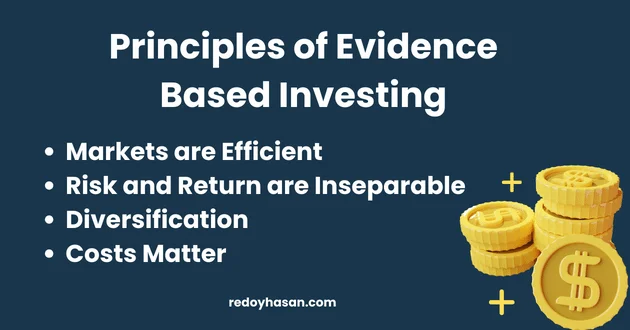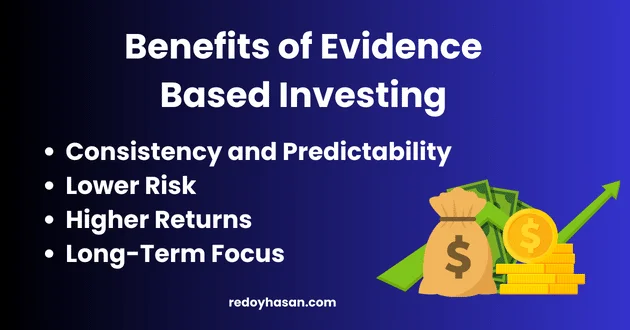
Welcome to our comprehensive guide on evidence-based investing! In today’s world, where information is constantly bombarding us from every direction, it can be challenging to make informed decisions about our investments. However, with evidence-based investing, we focus on using data and research instead of emotions and speculation to guide our investment decisions.
In this guide, we will explore the concept of evidence-based investing, its principles and benefits, and how to implement it in your own investment strategy. So, let’s dive in!
What is Evidence Based Investing?
Evidence-Based Investing (EBI) is a disciplined approach to asset management that combines comprehensive market data, scientific research, and investment insight. The key principles of EBI revolve around empirical evidence and validated research, suggesting that financial decision-making should be grounded in factual data, not conjecture or popular opinion. EBI advocates for minimizing expenses and costs related to investment activities and emphasizes reliance on long-term historical data to create robust and resilient portfolios.

Principles of Evidence Based Investing
Before we delve deeper into the mechanics of evidence-based investing, it is crucial to understand its guiding principles. These foundational tenets shape every aspect of the evidence-based investing approach, from the selection of assets to risk management. These principles not only distinguish evidence-based investing from other strategies, but they also provide the logical framework that informs investment decisions. In the following sections, we will discuss these principles in detail.
Markets are Efficient
Efficiency in global markets primarily refers to the speed and accuracy with which new information is incorporated into prices. It underscores the idea that market prices quickly respond to and reflect all available relevant information. This reflection of the information in prices implies that trying to outperform the market consistently is futile unless one has access to information before everyone else, which is not only improbable but also illegal in most instances.
In the digital age, this efficiency has been greatly enhanced by the increased data transfer speeds and advanced trading platforms. High-speed internet connections and cutting-edge technology infrastructure make it possible for new information to be disseminated and processed in mere seconds. Trading platforms, equipped with sophisticated tools and algorithms, allow for almost instantaneous execution of trades based on this information. This rapid dissemination and processing of information level the playing field, keeping markets efficient and ensuring that no single participant can consistently achieve risk-adjusted returns that exceed the market average.
Risk and Return are Inseparable
Risk and return are inseparable elements in the realm of investing and form an essential part of the decision-making process. The term ‘risk’ in investing refers to the probability of incurring a loss in your investment, while ‘return’ signifies the potential gain or profit that the investment can yield. These two elements are inherently linked, representing the fundamental trade-off in investing: the higher the potential return, the higher the risk of loss.
Investors constantly grapple with assessing and managing these factors. Understanding the risk associated with an investment is pivotal in estimating the potential return. This is often accomplished by analyzing historical data and employing various risk assessment models. On the other hand, expected return forms the basis for investment decisions, providing a benchmark against which performance can be measured.
Diversification
Diversification is a fundamental principle of evidence-based investing and an essential tool for managing risk and reducing volatility in an investment portfolio. It refers to the practice of spreading your investments among different assets or asset classes to avoid excessive exposure to any single source of risk. By distributing investments across a wide range of securities, investors can create a well-diversified portfolio that minimizes the impact of poor performance by any one investment.
Diversification works on the principle that different types of assets perform differently under varying market conditions. By mixing a variety of investments within a portfolio, the negative performance of some investments will likely be offset by the positive performance of others. This, in turn, reduces the overall volatility of the portfolio, mitigates risks, and provides a smoother investment journey.
Costs Matter
Another cornerstone of evidence-based investing is the understanding that costs matter significantly in the investment process. Every investment strategy comes with associated costs, and these expenses can eat into your returns over time, significantly impacting your overall investment performance.
Various cost factors exist within the investment landscape. These include transaction costs, which are the fees incurred every time a trade is executed; management fees, which are charged by fund managers for the service of managing your investments; and tax costs, which are the taxes paid on any profits made from investments. Other potential costs include the costs associated with market impact, research, and due diligence processes, among others.
Evidence-based investing advocates for the minimization of these costs where possible. This is achieved through practices such as holding onto investments for longer periods (to reduce transaction costs), investing in low-cost index funds or ETFs (to reduce management fees), and strategically planning the buying and selling of investments to minimize tax costs. By prioritizing cost-effective solutions, investors can retain a greater portion of their returns, leading to greater wealth accumulation over the long term.

Benefits of Evidence Based Investing
Adopting an evidence-based investing approach offers several advantages that contribute to achieving long-term financial goals. By understanding and applying the principles of evidence-based investing discussed earlier, investors can make informed decisions that align with their risk tolerance and expected returns. In the following sections, we will explore some of the key benefits that evidence-based investing offers.
Consistency and Predictability
One of the key benefits of evidence-based investing is the element of consistency and predictability it brings to the investment process. Just as maintaining a cohesive structure throughout a document allows for easier understanding and efficient information retrieval, adopting a consistent approach in investment decisions leads to better predictability of outcomes and reduces the likelihood of erratic, emotion-based decisions that could potentially harm an investor’s portfolio.
Achieving this consistency and predictability in evidence-based investing mirrors maintaining the same formatting style, headings, and language conventions throughout a document. It involves creating and adhering to a strategic investment plan, deploying similar evaluation metrics across investment decisions, and maintaining diligence and discipline in the face of market fluctuations.
Lower Risk
Evidence-based investing is a disciplined, cost-conscious investment approach that seeks to harness the power of market returns while minimizing unnecessary costs. This method is rooted in the belief that the market prices assets efficiently, and it’s next to impossible to consistently outperform the market through active trading. Instead, evidence-based investing focuses on keeping costs low, understanding that these expenses can considerably impact your returns over time.
The cost-effectiveness of this approach cannot be overstated. It is well-known in investing that costs and returns are inversely related — the higher the investment costs, the lower the returns, and vice versa. These costs can take many forms, including transaction fees, management fees, and taxes, each of which can eat away at your returns over the long term. By prioritizing low-cost or rules-based strategies, evidence-based investing strives to mitigate these costs, thereby maximizing the potential for higher returns.
Higher Returns
The ultimate goal of investing is to achieve positive returns and grow wealth over time. Evidence-based investing seeks to provide the best possible chance of reaching this goal by implementing a disciplined, data-driven approach to investment decisions. By incorporating strategies such as diversification and minimizing costs, evidence-based investing aims to maximize portfolio returns while keeping risk in check.
Over the long term, these small yet impactful decisions can lead to significant differences in investment outcomes. By avoiding common pitfalls such as excessive trading, market timing, and chasing hot stock tips, evidence-based investing offers a higher probability of achieving long-term financial goals.
Long-Term Focus
Evidence-based investing is a long-term strategy that focuses on achieving financial goals over extended periods. By maintaining a disciplined approach and adhering to sound investment principles, evidence-based investors are better equipped to weather short-term market fluctuations and stay invested for the long haul. This allows for a more stable and consistent approach to wealth accumulation, ultimately leading to greater financial security in the future.

Implementing Evidence Based Investing
Successfully implementing an evidence-based investing strategy calls for an understanding of its key components. These can be broadly categorized into the following areas: Knowledge and Understanding, Creating a Strategy, and Continual Monitoring and Adjustment. The subsequent sections will delve into these headings in detail, providing insights into the necessary steps for effectively applying evidence-based investing principles to achieve your financial goals.
Knowledge and Understanding
To successfully implement evidence-based investing, investors need to understand the key principles that underpin this approach. This includes having a basic understanding of markets, risk, diversification, and other investment concepts. Without this knowledge, it would be challenging to make informed decisions and assess the quality of evidence available.
Investors can acquire this knowledge through various resources such as books, articles, or online courses. They can also seek the guidance of a financial advisor who specializes in evidence-based investing and is well-versed in its principles.
Creating a Strategy
Once investors have a solid understanding of the key concepts involved, they need to create an evidence-based investment strategy that aligns with their risk tolerance and long-term financial goals. This strategy should be data-driven, incorporating sound investment principles such as diversification and minimizing costs. It should also have a long-term focus to avoid being swayed by short-term market fluctuations.
Continual Monitoring and Adjustment
An essential part of evidence-based investing is continually monitoring and adjusting your portfolio as needed. Regularly reviewing your investments allows you to ensure that they remain aligned with your financial goals and risk tolerance. It also helps to identify any potential issues that may arise, such as the need for rebalancing or changing investment strategies.
By consistently monitoring and making adjustments based on evidence rather than emotions or market trends, investors can stay on track towards achieving their long-term financial objectives.
Conclusion
Evidence-based investing is a disciplined approach that seeks to achieve long-term financial goals through a data-driven, cost-conscious investment strategy. By prioritizing low-cost and rules-based strategies, maximizing returns while minimizing risk, and maintaining a long-term focus, evidence-based investing provides investors with the best possible chance of success in an ever-changing market landscape. Whether you are just starting your investing journey or have been at it for years, implementing evidence-based investing principles can help you achieve your financial goals and secure a better future for yourself and your loved ones. So, it is always advisable to adopt evidence-based investing strategies to improve the chances of success in the long term.
Read more article:


